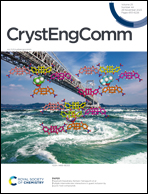Alternating [ML2(MeOH)2] and [ML2(EtOH)2] layers in low-temperature ferromagnets [ML2(MeOH)2][ML2(EtOH)2] (M = CoII, NiII or Co II0.5Ni II0.5)†
Abstract
Bimolecular complexes [ML2(MeOH)2][ML2(EtOH)2], where M is CoII, NiII or CoII0.5NiII0.5 and L is a deprotonated enaminoketone 4-(3′,3,3′-trifluoro-2′-oxopropylidene)-2,2,5,5-tetramethyl-3-imidazolidin-1-oxyl, were found to be isolated in the solid phase from a solution containing MeOH and EtOH in the ratio 1 : 10. Their solids have a layered-polymer structure due to hydrogen bonds between the OH-groups of the coordinated ROH molecules and nitroxide groups of the neighboring [ML2(ROH)2] molecules. The peculiar crystal structures of [ML2(MeOH)2][ML2(EtOH)2] have ordered alternation of methanol- and ethanol-containing supramolecular layers. Detailed crystallochemical analysis showed that during the formation of [ML2(MeOH)2][ML2(EtOH)2] crystals, the MeOH containing layer is significantly deformed in comparison with the [ML2(MeOH)2] structure. This indicates that the ethanol-containing layer determines the crystal formation, while the {ML2(MeOH)2} layer “adjusts” to it. Magnetochemical study of the bimolecular complexes [ML2(MeOH)2][ML2(EtOH)2] revealed magnetic ordering at low temperatures.
![Graphical abstract: Alternating [ML2(MeOH)2] and [ML2(EtOH)2] layers in low-temperature ferromagnets [ML2(MeOH)2][ML2(EtOH)2] (M = CoII, NiII or CoII0.5NiII0.5)](/en/Image/Get?imageInfo.ImageType=GA&imageInfo.ImageIdentifier.ManuscriptID=D3CE00912B&imageInfo.ImageIdentifier.Year=2023)


 Please wait while we load your content...
Please wait while we load your content...